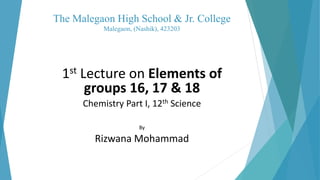
1st Lecture on Elements of groups 16, 17 & 18 | Chemistry Part I | 12th Std
- 1. The Malegaon High School & Jr. College Malegaon, (Nashik), 423203 1st Lecture on Elements of groups 16, 17 & 18 Chemistry Part I, 12th Science By Rizwana Mohammad
- 2. Elements of groups 16, 17 and 18 In the p-block elements the differentiating electron (the last filling electron) enters the p-orbital of the outermost shall. Occurrence: • The elements oxygen, sulphur, selenium, tellurium and polonium constitute group 16, called the oxygen family. • Large number of metal ores are oxides or sulphides. • Group 16 elements are also called Chalcogens. • Oxygen is the most abundant element on earth. • Oxygen forms 20.95% by volume of air and 46.6% by mass of earth's crust. • Sulphur forms 0.034% by mass of earth crust. • Sulphur occurs mainly in combined forms as sulphates such as gypsum (CaSO4, 2H2O), epsum salt (MgSO4, 7H2O), baryte (BaSO4) and sulphides such as galena (PbS), zinc blend (ZnS), copper pyrites (CuFeS2).
- 3. • Selenium and tellurium are also found as metal selenides and tellurides in sulphide ores. • Polonium which is radioactive is a decay product of thorium and uranium. • Fluorine, chlorine, bromine, iodine and astatine constitute group 17. • These are collectively known as halogens (Greek halo means salt, gene means born), i.e. salt producing element. • Halogens are very reactive due to high electronegativities and hence they are not found in free state. • Fluorine occurs mainly as insoluble fluorides (Fluorspar CaF2, Cryolite Na3AlF6, fluorapatite 3Ca3(PO4)2.CaF2), and small quantities are present in soil, fresh water and plants, bones and teeth of animals. • Sea water contains chlorides, bromides and iodides of Na, K, Mg, Ca. The deposits of dried up sea beds contain NaCl and carnallite, KCl.MgCl2.6H2O. • Sea weed contains 0.5% I and chile saltpetre contains 0.2% of sodium iodate. • Astatine is radioactive and has a half life of 8.1 hours.
- 4. • Helium, neon, argon, krypton, xenon, radon constitute group 18. • All the noble gases except radon occur in the atmosphere. • Their abundance in dry air is ≈ 1% (by volume), argon is the major constituent. • Helium and neon are found in minerals of radioactive origin, e.g. pitchblende, monazite, cleveite. • Xe and Rn are the rarest element. • Rn is a decay product of 226Ra. Electronic configuration of elements of group 16, 17 and 18:
- 5. Atomic and physical properties of elements of group 16, 17 and 18: Atomic properties of group 16, 17 and 18 elements: i. Atomic and ionic radii: In group 16, 17, 18 atomic and ionic radii increase down the group, due to increase in the number of quantum shells. • Across the period atomic or ionic radii decrease with increasing atomic number. • Group 17 elements have the smallest atomic radii in their respective periods. ii. Ionization enthalpy: • The group 16, 17, 18 elements have high ionisation enthalpy. • The ionisation enthalpy decreases down the group due to increase in the atomic size. • Across a period ionisation enthalpy increases with increase of atomic number. • The elements of group 16 have lower IE values compared to those of group 15 in corresponding periods. • It is due to extra stable half filled electronic configuration of p-orbitals in elements of group 15. iii. Electronegativity: • In a group (16, 17, 18) the electronegativity decreases down the group. • Oxygen has the highest electronegativity next to fluorine.
- 6. • Halogens have very high electronegativity. • F is the most electronegative element in the periodic table. Electron gain enthalpy: • In the group 16 and 17 electron gain enthalpy becomes less negative down the group. • In group 16, oxygen has less negative election gain enthalpy (-141kJ/mol) than sulphur (-200 kJ/mol) due to its small atomic size. • In group 17, F has less negative electron gain enthalpy (-333 kJ/mol) than that of chlorine (-349 kJ/mol). • It is due to its small atomic size. • Group 18 elements have no tendency to accept electrons because of their stable electronic configuration (ns2 np6). • They have large positive electron gain enthalpy.
- 7. Physical properties of group 16, 17 & 18 elements: a. Group 16 elements (oxygen family or chalcogens): • Oxygen is a gas while other elements are solids at room temperature. O and S are metals, Se and Te are metalloids, Po is a metal. • Po is radioactive with half life of 13.8 days. • Melting and boiling points increase with increasing atomic number. • All the elements of group 16 exhibit allotropy. b. Group 17 elements (Halogen family): • F, Cl are gases, Br is a liquid and I is a solid at room temperature. • F2 is yellow, Cl2 greenish yellow, Br2 red and I2 is violet, in colour. • F and Cl react with water. • Br and I are only sparingly soluble in water and are soluble in various organic solvents such as chloroform, carbon disulphide, carbon tetrachloride, hydrocarbons which give coloured solutions. • Bond dissociation enthalpies of halogen molecules follow the order • Cl – Cl > Br – Br > F – F > I – I.
- 8. c. Group 18 elements (Noble gases): • Noble gases are monoatomic. • They are sparingly soluble in water. • Noble gases have low melting and boiling points. He has the lowest boiling point (4.2k) of any know substance.
